Did you know cholesterol levels are higher in the winter than summer?
Just like our recently discussed buddy testosterone, cholesterol has a rhythm expressed both both daily and annually. Although several things can acutely impact cholesterol and cause fluctuations, two important cycles to keep in mind are its daily and yearly rhythm. On a daily basis, cholesterol is highest in the middle of the day and lower in the early morning and evening. On a yearly basis, cholesterol peaks in the winter (Nov-Jan) and is at it's lowest in the summer (Jun-Aug). This variation ranges from a 3-5% difference, up to 15-20% difference, depending on several factors, although the reasons for why this is observed has yet to be established. It has been hypothesized that blood volume, due to seasonal temperature changes might explain some of this but I think there's a bit more biological nuance in play.
For the people interested in a bit more detail, read the entire article. For the people who just need the basic concept, know this: There is some seasonal variation and it is seen a bit more in women and high cholesterol populations, although lower cholesterol populations see more percentage/relative change. If you get your cholesterol tested in the winter it might be anywhere from a bit higher to considerably higher than if tested in the summer and it's likely to be a bit higher in the middle of the day than in the morning or evening. This is helpful for general knowledge since many people are "borderline" high cholesterol (it may simply be a winter peak) and is even more important for retesting. Make sure your variables of time and season are controlled if you're looking for if a change has taken place.
For most people that is really all one need know. For the others out there like myself that tend to dive deeper, here's a bit more on the annual rhythm (I only expanded on yearly changes because I think that it's more well studied and impactful and daily cholesterol fluctuations are less well established and are likely impacted by too many variables to tackle here)...
Cholesterol Annual Rhythm ResearchThe seasonality of cholesterol levels has been noticed for some time and studied relatively extensively. Although a few studies haven't shown statistical significance, most research points toward a noticeable difference between winter levels and summer levels. As mentioned above, the reasons for this is yet to be discovered but hypotheses have included dietary changes, temperature variations and activity changes. In looking around at some of the research I came across two studies I wanted to share.
Seasonal Variation in Serum Cholesterol Levels (2004)
A pretty simple study done about 10 years ago looked at Total Cholesterol, LDL, HDL and Triglycerides for both men and women. Here's the results:
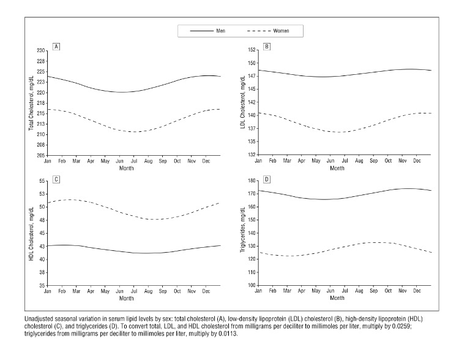
Not tremendous variation but definitely noticeable and statistically significant in several measurements, with the most difference seen in women and people with "high" baseline (>240) cholesterol*. The authors concluded that although this was less variation than most similar research has shown it is still enough to warrant acknowledgement when screening for cholesterol. The explaination offered is that seasonal variations are likely due to changes in blood volume, which would concentrate the blood's contents more in the colder months, therefore raising the blood test scores. This, as they referenced, has been seen to register up to 100 point differences in extreme weather climates such as Finland.
*Note: most research finds women to have higher cholesterol than men on average, this study found the opposite. However, they found that the greatest differences were found in high cholesterol folks and women, who traditionally have higher cholesterol. Nothing groundbreaking here but thought it was a very straightforward look at the question that provided good visual representation of the data. Additionally, it reinforced the idea that the people most likely to be measuring, tracking and managing cholesterol are the ones who have the most variation during a year.
The study that really peaked my interest was this:
A group of German researchers set out to determine the influence of diet and exercise on cholesterol annual rhythms. They found that diet and exercise weren't the controlling factors in cholesterol annual rhythm. In essence, cholesterol was higher in the winter and lower in the summer regardless of diet or exercise variation. Although this was interesting as a broad finding, the details were what I found intriguing. Here are the groups they studied over a two year period:
Group A: Vegetarians
Group B: Athletes
Group C1: Control group young (age 20-26)
Group C2: Control group older (age 40-48)
The basic cholesterol data, using the universal mmol/L measurement is below. American testing uses mg/dl so I did some basic conversion for ease of comparison. A total cholesterol of 5.5 mmol/L translates to about 215 mg/dl, 4.5 equals 175, 3.5 equals 135. Every 1.0 is about 40 points.
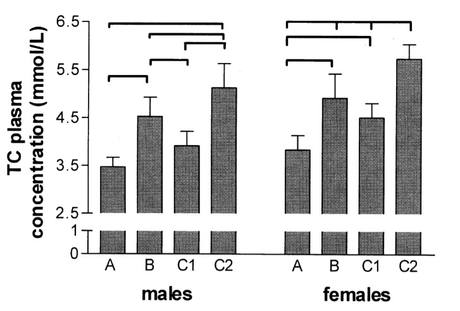
Some quick observations: Women had higher cholesterol across all groups by about 20 points. The older control group had the highest cholesterol averaging ~215, followed by athletes (~185), young control group (~165) and vegetarians (~140). Nothing terribly surprising there but looking at the annual rhythms and group differences a few things started to stand out. Chart 1 is the men, Chart 2 is women:
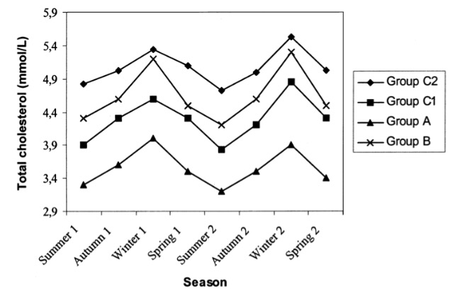
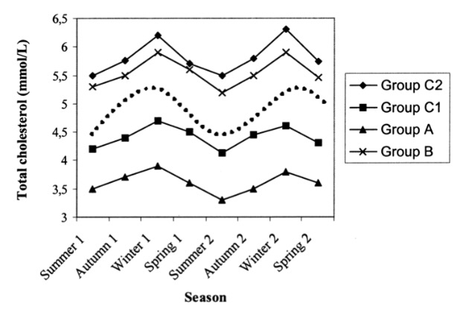
Men
Looking at the men, the 3 non exercise groups are virtually identical in blood cholesterol change, regardless of if they were high or low baseline cholesterol. That means the older control group and vegetarians both saw the same absolute change seasonally (about 20 points), despite the fact the vegetarians cholesterol was considerably lower (about 50 points). This means that the vegetarian group actually experienced the biggest relative/percentage change from season to season of all non exercisers. The male athletes experienced the biggest change both absolute (40 points) and relative (20%). This is likely explained from the following graph:
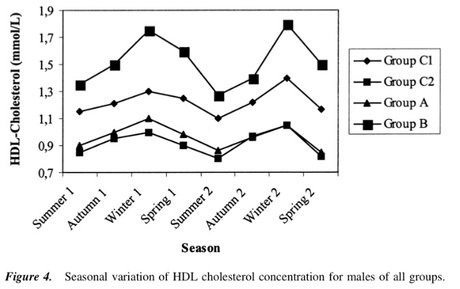
HDL increased considerably more in the winter in these male athletes and explains the added seasonal change seen in the overall cholesterol score.
Women
Going back to overall cholesterol in the women, what stands out is how similar the rhythm of each group, even the athletes. Second is how different the cholesterol numbers are between the higher and lower groups. The female athletes and older controls had cholesterol numbers ranging from 200 to 250 while the vegetarians had a range from 125 to 150 and the younger control group was somewhere between the two. So hypothetically you could have a vegetarian friend test their cholesterol in the summer and get a score of 125 and another friend who was an avid exerciser who gets their cholesterol tested 6 months later and gets a 250. Both could be healthy and one would have cholesterol double the other. One would be commended for their "great cholesterol" and the other, that I would argue is potentially healthier, would be having the unhealthy high cholesterol discussion with their doctor. Even if the vegetarian tested in the winter and got 150 and the athlete tested in the summer at 200, that's still a tremendous difference.
Let's look at the HDL scores to see if that's part or all of the difference:
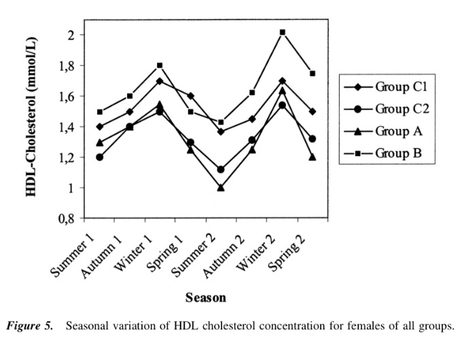
More tightly grouped with a little crossover of groups, unlike the men that were spread out more and had almost no crossover. Vegetarian and older women had lowest HDL while young controls and athletes were higher.
What can we take away from these two studies, the second one in particular?
Nothing for certain since these are just two studies and nothing in this health world is absolute but it does appear that it's a good idea to keep the concepts in mind they discuss or suggest in mind?
What can we take away from the bigger picture of cholesterol research?
Cholesterol fluctuates seasonally, with a natural pattern that develops and is consistent across different populations but how much variation we might see probably differs from population to population and individual to individual. As always, there's continued need to explore further but I think this hints at some deeper biology that, when we fully understand it, will likely clear up much of our confusion surrounding cholesterol and many other biological substances and processes.
For now, I would stick with this: Don't take a cholesterol test on a summer morning and then compare it to a followup test taken on a winter afternoon. You just may be looking at a statin prescription. :)
Thanks for reading, have a great day!
Categories: Cholesterol, Health & Wellness, Human Function, Nature | Tags: adaptation, biology, cholesterol, cholesterol annual cycle, cholesterol changes, cholesterol circannual, cholesterol levels, cholesterol rhthym, circadian, circadian rhythm, diet and cholesterol, hdl cholesterol, natural, why is cholesterol high, yearly rhythm | Permalink.


